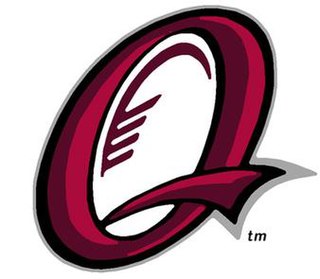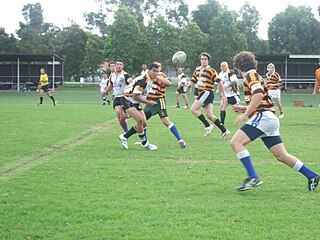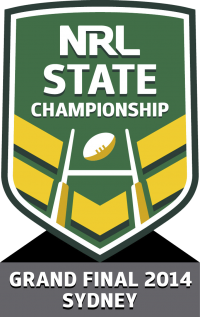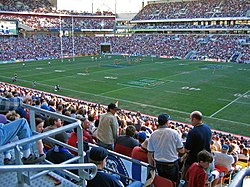
The New South Wales Rugby League (NSWRL) is the governing body of rugby league in New South Wales and the Australian Capital Territory and is a member of the Australian Rugby League Commission. It was formed in Sydney on 8 August 1907 and was known as the New South Wales Rugby Football League (NSWRFL) until 1984. From 1908 to 1994, the NSWRL ran Sydney's, then New South Wales', and eventually Australia's top-level rugby league club competition from their headquarters on Phillip Street, Sydney. The organisation is responsible for administering the New South Wales rugby league team.

The Queensland Rugby Football League (QRL) is the governing body for rugby league in Queensland. It is a member of the Australian Rugby League Commission and selects the members of the Queensland rugby league team.

The Redcliffe Dolphins are a semi-professional rugby league club based in Redcliffe, Queensland, Australia. Founded in 1947, they were accepted into the Brisbane Rugby League (BRL) premiership competition in 1960, and since 1996 have played in the Queensland Cup. The Redcliffe Dolphins thrived in the BRL. However, the 1988 admission of the Brisbane Broncos team in the New South Wales Rugby League competition caused the decline of the BRL.

The Queensland Cup, currently known as the Hostplus Cup for sponsorship reasons, is the highest-level regional rugby league football competition in Queensland, Australia. It is run by the Queensland Rugby League (QRL) and is contested by fifteen teams, thirteen of which are based in Queensland, with one based in New South Wales and one in Central Province, Papua New Guinea.

Central Queensland Capras are a semi-professional rugby league football club primarily based in Rockhampton, Queensland and representing Central Queensland. They currently play in the Queensland Cup, the premier rugby league competition in Queensland. From 2023, they will serve as one of the feeder clubs for the Dolphins.
The Brisbane Rugby League was a rugby league football competition in Brisbane, Queensland, Australia. It was first held in 1922 and for every year until 1997. The competition was reinstated in 2001, known as the FOGS premiership under the Queensland Cup. The competition consists of Brisbane's top six rugby league clubs. Each participating team is a feeder club for the Queensland Cup.
John Ribot, also known by the nickname of "Reebs", is an Australian sports administrator, former rugby league footballer of the 1970s and 1980s. Once a Queensland State of Origin and Australian international representative, Ribot was the 1980 NSWRFL season's equal top try-scorer. Also a member of the 1982 "Invincibles" Kangaroo touring squad, he played club football in Brisbane for Fortitude Valley, Wests and Redcliffe, and in Sydney for Newtown, Wests and Manly-Warringah.
Kevin David Walters is an Australian professional rugby league football coach who is the Head Coach of the Brisbane Broncos in the NRL and a former professional rugby league footballer who played as a premiership-winning five-eighth and halfback in the 1980s, 1990s and 2000s.
The history of the Brisbane Broncos Rugby League Football Club stretches back from their inception in the mid-1980s to the present day. They were introduced to the NSWRL's Winfield Cup premiership in 1988, taking the competition by storm in winning their first six games. The Broncos participated in 18 consecutive finals series from 1992–2009, winning premierships six times, including the 1992 and 1993 NSWRL premierships, the Superleague premiership in 1997 and then the 1998, 2000 and 2006 National Rugby League premierships.
Greg Conescu is an Australian former professional rugby league footballer. An Australia national and Queensland State of Origin representative hooker, he played all of his club football in Queensland with Norths Devils Gladstone Brothers, Redcliffe and the Brisbane Broncos.

The FOGS Colts Challenge is an 11-team rugby league competition run by the QRL. It is the highest level of junior rugby league in Brisbane before players move into senior rugby. FOGS in an acronym for Former Origin Greats.
The Australian rugby league premiers are the winners of the top grade competition in Australian rugby league, which is currently the National Rugby League. From 1908 until 1994, when the ARL Premiership was formed, there were two premiers, one each from Sydney and Brisbane. This occurred again in 1997 during the Super League war.

Rugby league, in New South Wales, is the most popular participation and spectator sport. It currently has the highest attendance and television audiences of the various codes of football in the state, far outstripping any other competitors. The state has over 400,000 active participants in the sport with a further 1 million playing the sport in schools, over 500 active clubs across the state, and 10 clubs in the national professional competition, named the NRL.

The NRL State Championship is a rugby league match contested by the premiers of the two elite second-tier competitions in Australia, the New South Wales Cup and the Queensland Cup. The match has been played as a curtain-raiser to the NRL Grand Final at Stadium Australia since it was introduced by the National Rugby League (NRL) in 2014. The match acts as a Super Bowl-style game to determine the National Reserve Grade Champions.
The National Rugby League (NRL) is the top league of professional rugby league clubs in Australasia. Run by the Australian Rugby League Commission, however, there has not been a league-wide Reserve Grade competition since 1988, when the former New South Wales Rugby League expanded interstate to make the first attempt at a national competition, with the NRL Reserve Grade competition being shut down at the end of the 2002 season.
Maitua Feterika is a New Zealand rugby league footballer.

The Hastings Deering Colts is a junior rugby league competition based in Queensland, contested among teams made up of players aged 21 or under. The competition is administered by the Queensland Rugby League (QRL), and is contested by fourteen teams, thirteen of which are located in Queensland and one in New South Wales.
Vanessa Foliaki is a New Zealand-born Australian rugby league footballer who plays for the Sydney Roosters in the NRL Women's Premiership and the Wentworthville Magpies in the NSWRL Women's Premiership.

Tamika Upton is an Australian professional rugby league footballer who currently plays for the Newcastle Knights in the NRL Women's Premiership. Her position is fullback. She previously played for the Brisbane Broncos in the NRLW, and the Burleigh Bears in the QRL Women's Premiership.
The 1987 Brisbane Rugby League premiership was the 77th season of Brisbane's semi-professional rugby league football competition. Nine teams from across Brisbane competed for the premiership, which culminated in a grand final match between the Redcliffe and Past Brothers clubs.












